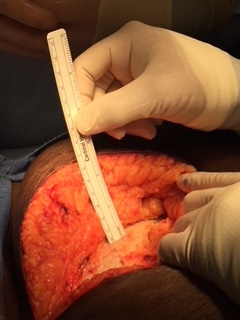Pinching an Inch in Kidney Transplantation: Subcutaneous Depth as a Risk Factor for Wound Complications
Baylor All Saints Medical Center, Fort Worth.
Meeting: 2018 American Transplant Congress
Abstract number: C161
Keywords: Kidney transplantation, Obesity
Session Information
Session Name: Poster Session C: Kidney Technical
Session Type: Poster Session
Date: Monday, June 4, 2018
Session Time: 6:00pm-7:00pm
 Presentation Time: 6:00pm-7:00pm
Presentation Time: 6:00pm-7:00pm
Location: Hall 4EF
Wound complications after kidney transplant (KTx) consume valuable resources, including prolonged hospital stays and increased costs. Known risk factors include immunosuppression exposure, diabetes, and obesity as measured by body mass index (BMI). However, BMI is not an accurate surrogate of body habitus. In this study, we sought to determine the effect of subcutaneous depth (SQD) on KTx outcomes, specifically wound complications.
SQD was measured as the distance from the fascia to the skin edge at the midpoint of the lateral portion of the incision, to the closest 0.5cm. 
 Data collected included the presence of diabetes or hypertension, previous transplant, PRA, pretransplant dialysis and induction therapy. Post transplant complications analyzed included wound infection, fascial dehiscence, lymphocele, renal artery thrombosis/stenosis, urine leak, ureteral stenosis and need for vacuum assisted closure therapy.
Data collected included the presence of diabetes or hypertension, previous transplant, PRA, pretransplant dialysis and induction therapy. Post transplant complications analyzed included wound infection, fascial dehiscence, lymphocele, renal artery thrombosis/stenosis, urine leak, ureteral stenosis and need for vacuum assisted closure therapy.
We measured SQD in 97 KTx only (79 cadaveric;18 living donor) recipients over 18 months. Mean age of recipients (56M:41F) was 48 years, with a mean BMI 27.8 and mean SQD 2.9cm. Patients with a SQD >2.5cm were more likely to require a wound vacuum assist device (average length of therapy, 46.6 days) compared to those with a SQD <2.5cm (p=0.0054), but did not develop significantly more technical complications. On multivariate regression adjusting for a history of diabetes and a BMI>25, SQD >2.5cm was still associated with a higher likelihood of requiring a wound vac (odds ratio 3.4).
In summary, SQD >2.5cm is an independent risk factor for requiring negative pressure vacuum therapy. This is a simple, measurable intraoperative method to stratify those at risk for later intervention.
(More data to be collected & analyzed prior to ATC).
CITATION INFORMATION: Ruiz R., Cox T., Wicklund K., Jennings N., Onaca N., Testa G., Anthony T., Fernandez H., Bayer J., McKenna G. Pinching an Inch in Kidney Transplantation: Subcutaneous Depth as a Risk Factor for Wound Complications Am J Transplant. 2017;17 (suppl 3).
To cite this abstract in AMA style:
Ruiz R, Cox T, Wicklund K, Jennings N, Onaca N, Testa G, Anthony T, Fernandez H, Bayer J, McKenna G. Pinching an Inch in Kidney Transplantation: Subcutaneous Depth as a Risk Factor for Wound Complications [abstract]. https://atcmeetingabstracts.com/abstract/pinching-an-inch-in-kidney-transplantation-subcutaneous-depth-as-a-risk-factor-for-wound-complications/. Accessed December 16, 2025.« Back to 2018 American Transplant Congress
